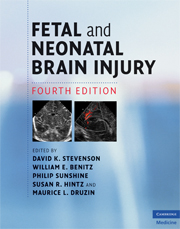Book contents
- Frontmatter
- Contents
- List of contributors
- Foreword
- Preface
- Section 1 Epidemiology, pathophysiology, and pathogenesis of fetal and neonatal brain injury
- Section 2 Pregnancy, labor, and delivery complications causing brain injury
- Section 3 Diagnosis of the infant with brain injury
- Section 4 Specific conditions associated with fetal and neonatal brain injury
- Section 5 Management of the depressed or neurologically dysfunctional neonate
- 39 Neonatal resuscitation: immediate management
- 40 Improving performance, reducing error, and minimizing risk in the delivery room
- 41 Extended management following resuscitation
- 42 Endogenous and exogenous neuroprotective mechanisms after hypoxic–ischemic injury
- 43 Neonatal seizures: an expression of fetal or neonatal brain disorders
- 44 Nutritional support of the asphyxiated infant
- Section 6 Assessing outcome of the brain-injured infant
- Index
- Plate section
- References
43 - Neonatal seizures: an expression of fetal or neonatal brain disorders
from Section 5 - Management of the depressed or neurologically dysfunctional neonate
Published online by Cambridge University Press: 12 January 2010
- Frontmatter
- Contents
- List of contributors
- Foreword
- Preface
- Section 1 Epidemiology, pathophysiology, and pathogenesis of fetal and neonatal brain injury
- Section 2 Pregnancy, labor, and delivery complications causing brain injury
- Section 3 Diagnosis of the infant with brain injury
- Section 4 Specific conditions associated with fetal and neonatal brain injury
- Section 5 Management of the depressed or neurologically dysfunctional neonate
- 39 Neonatal resuscitation: immediate management
- 40 Improving performance, reducing error, and minimizing risk in the delivery room
- 41 Extended management following resuscitation
- 42 Endogenous and exogenous neuroprotective mechanisms after hypoxic–ischemic injury
- 43 Neonatal seizures: an expression of fetal or neonatal brain disorders
- 44 Nutritional support of the asphyxiated infant
- Section 6 Assessing outcome of the brain-injured infant
- Index
- Plate section
- References
Summary
Introduction
Neonatal seizures are one of the few neonatal neurological conditions that require immediate medical attention. While prompt diagnostic and therapeutic plans are needed, multiple challenges impede the physician's evaluation of the newborn with suspected clinical and electroencephalographic (EEG) manifestations of neonatal seizures, which vary dramatically from those in older children. Recognition of the seizure state remains the foremost challenge to overcome. This dilemma is underscored by the brevity and subtlety of the clinical repertoire of the neonatal neurological examination.
Basic issues still remain regarding the recognition and treatment of neonatal seizures (Table 43.1). Which newborns with seizures to treat, and how to treat them, continues to occupy much discussion and controversy in written and oral presentations. While clinical seizures remain a common occurrence in neonatal intensive care settings, with an incidence as high as 2.6/1000 live births for term infants and 30–130/1000 live preterm births, increasing use of bedside EEG monitoring has resulted in the growing recognition that the incidence of seizures may be even higher. Yet the “who” question in the algorithm to diagnose and treat neonatal seizures includes a heterogeneous cohort of newborns who may present throughout the neonatal period (i.e., 30 days post-term). The manner of clinical presentation will reflect alternative diagnostic explanations for seizure recurrence based on timing, etiology, or brain region of injury. Presentation may imply part of a longer-standing encephalopathic process prior to and/or during parturition in some newborns.
- Type
- Chapter
- Information
- Fetal and Neonatal Brain Injury , pp. 499 - 526Publisher: Cambridge University PressPrint publication year: 2009
References
- 1
- Cited by



